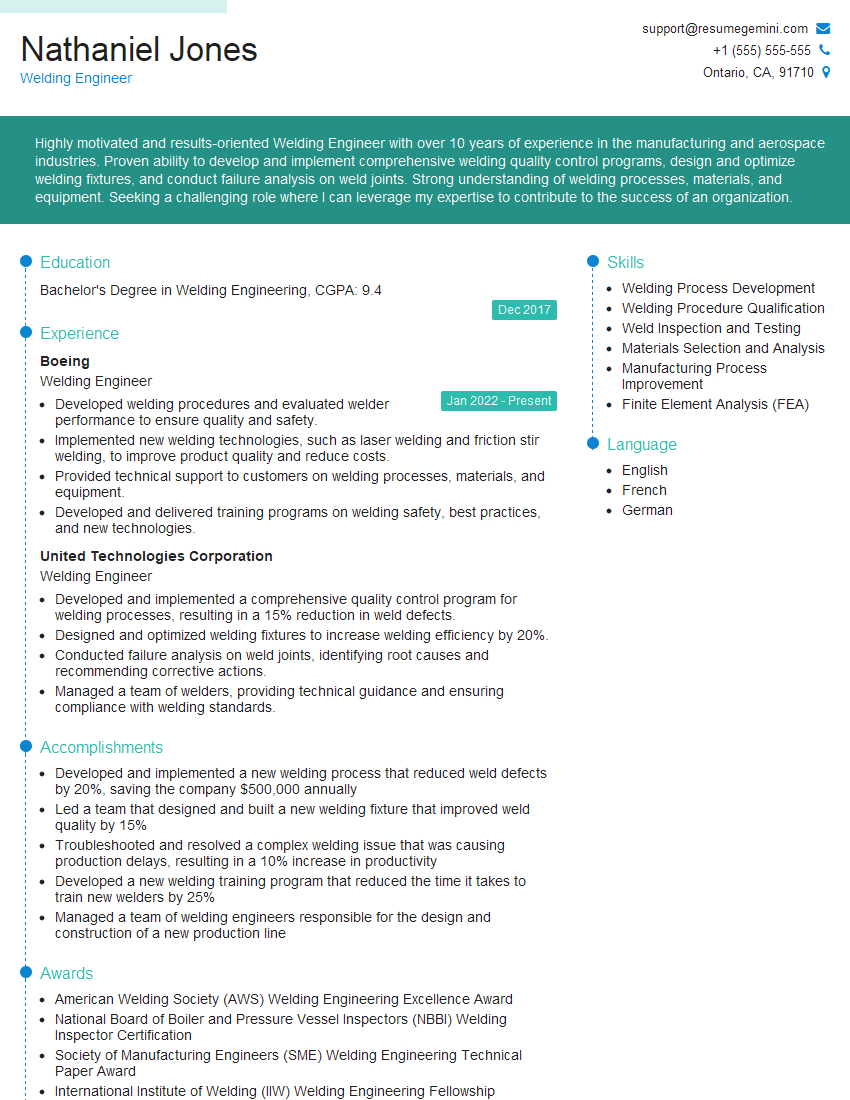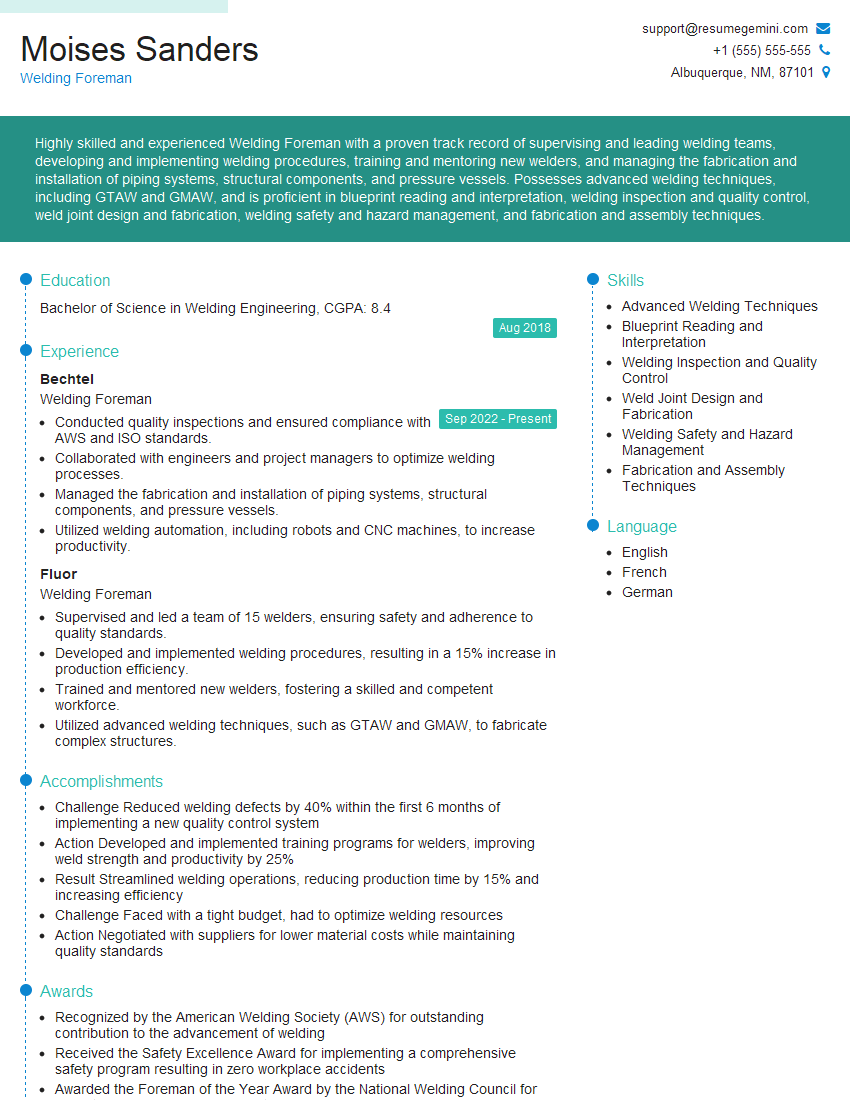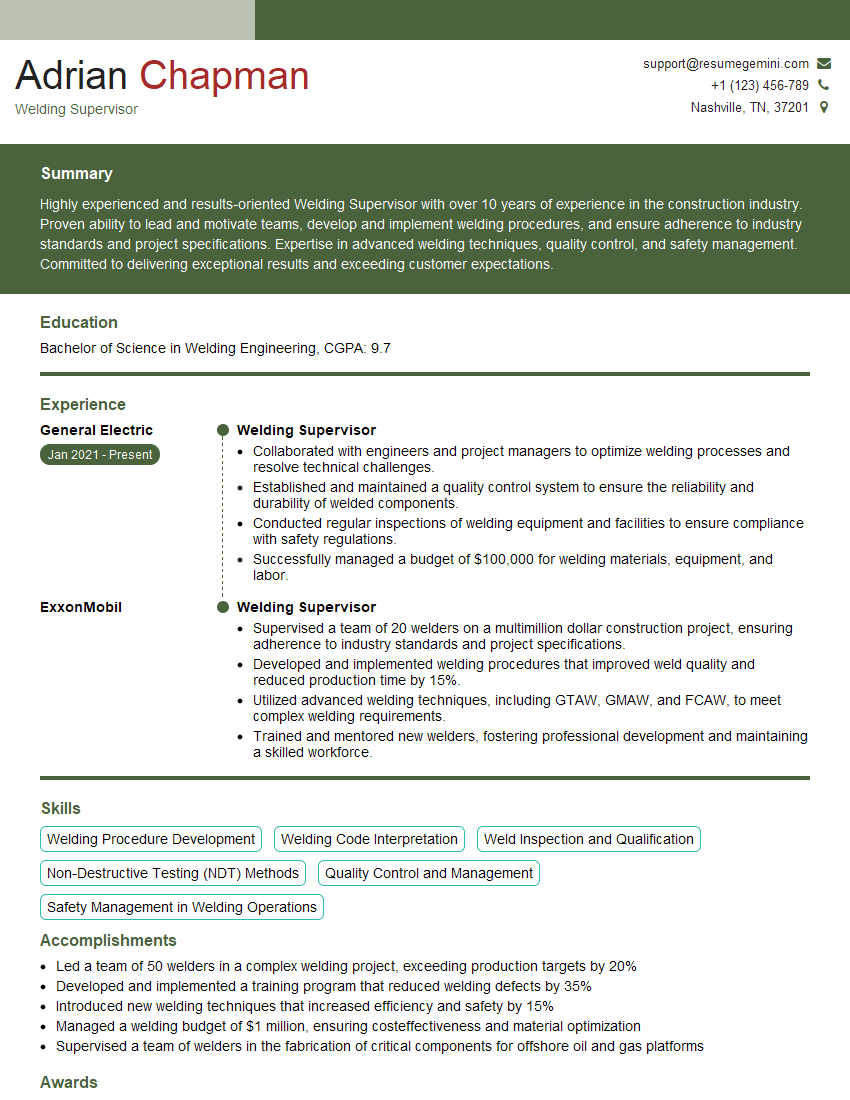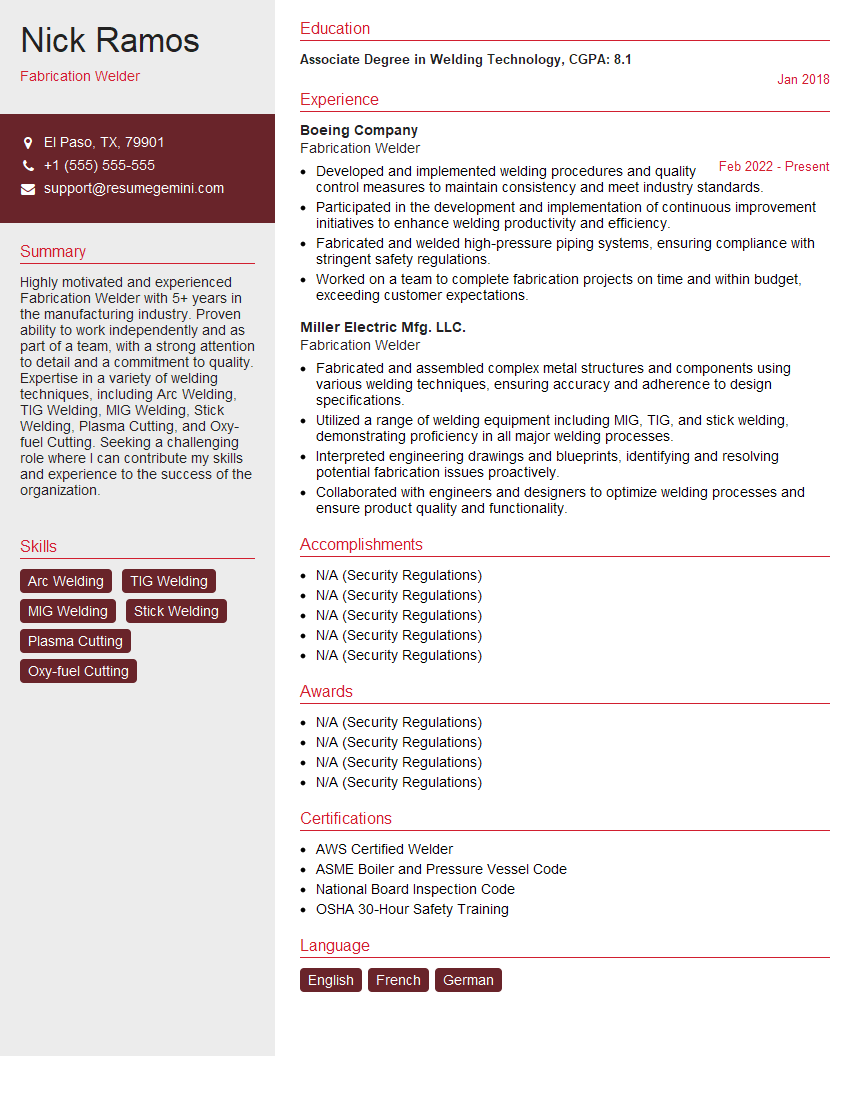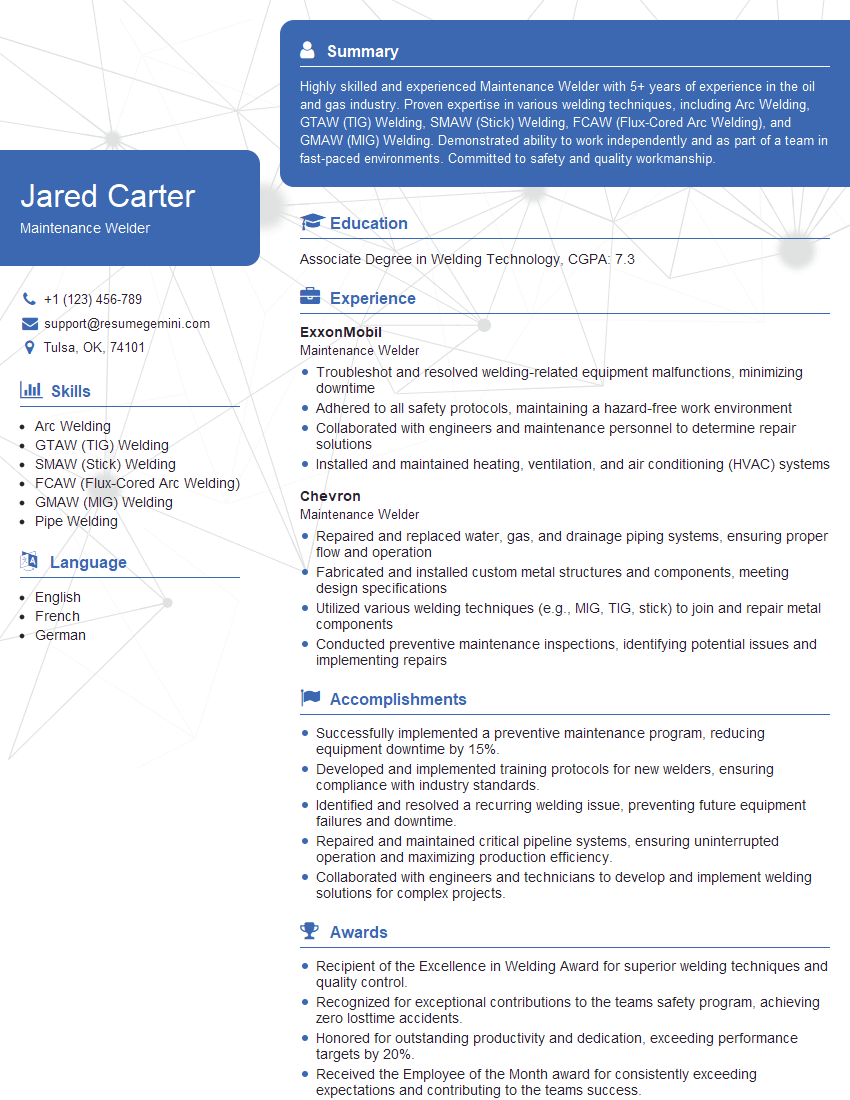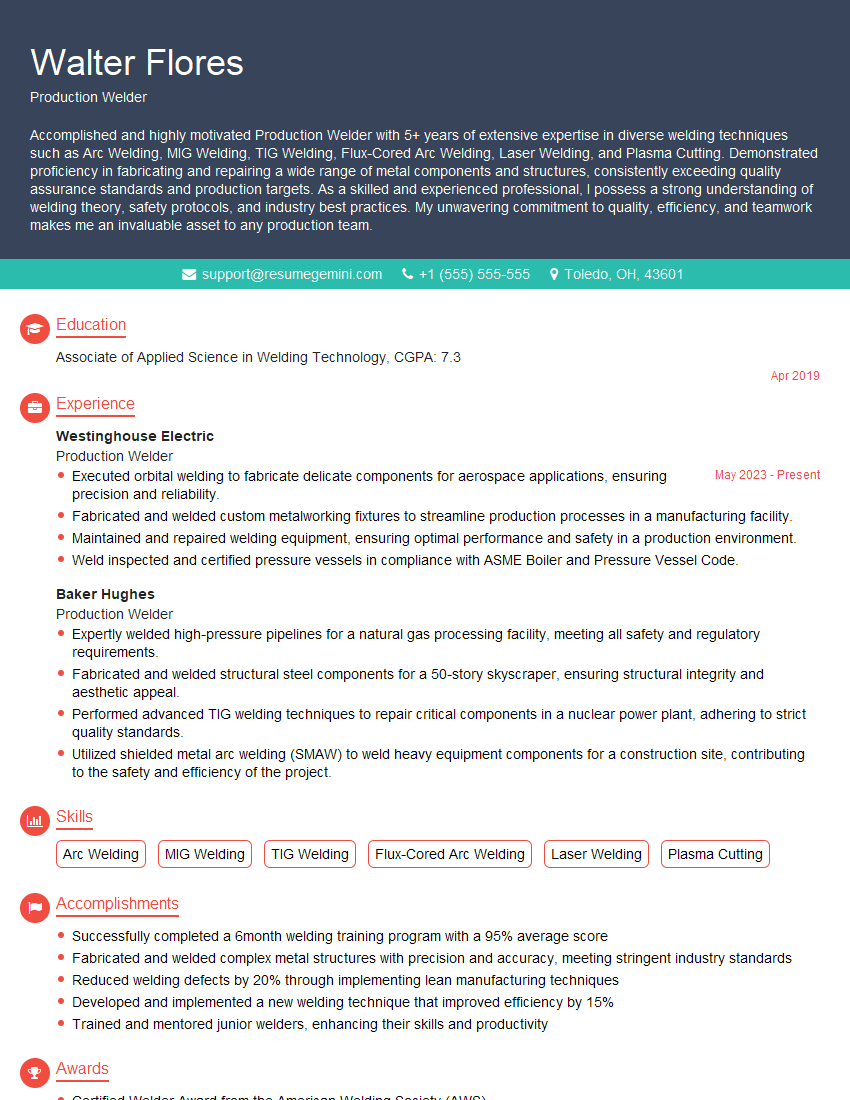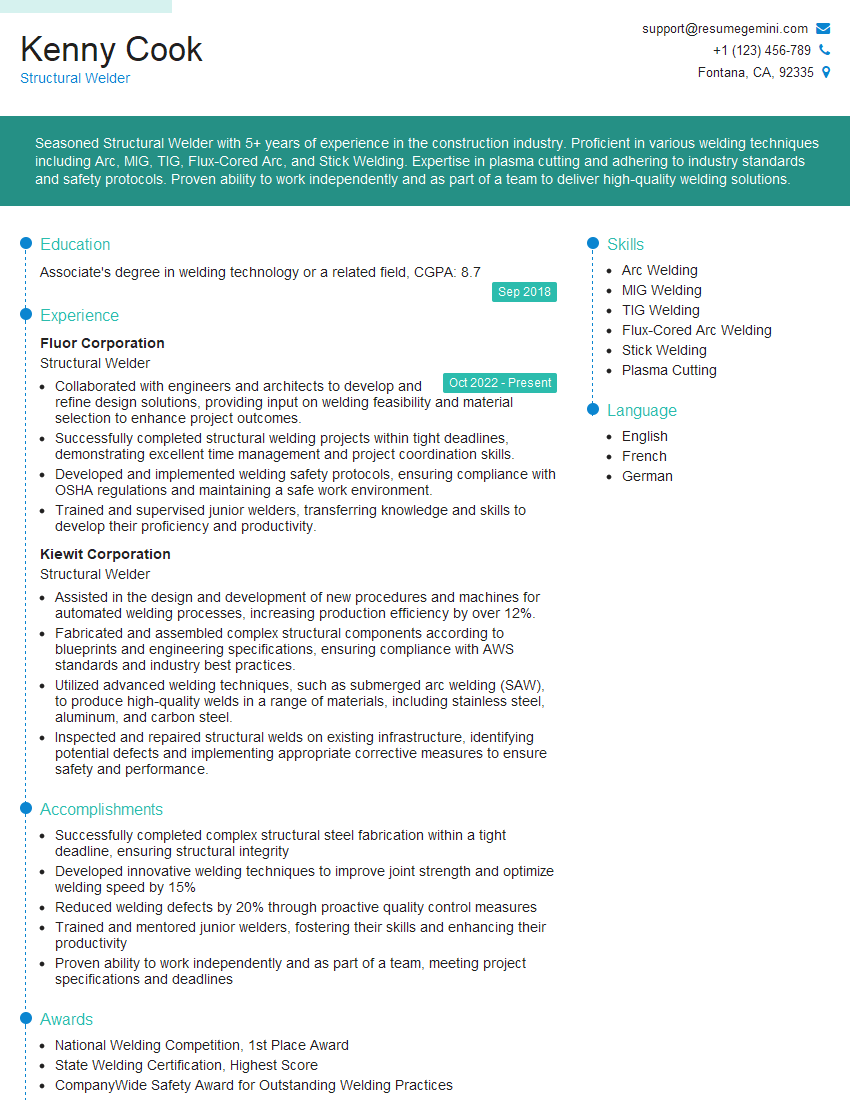Cracking a skill-specific interview, like one for T-Joint Welding, requires understanding the nuances of the role. In this blog, we present the questions you’re most likely to encounter, along with insights into how to answer them effectively. Let’s ensure you’re ready to make a strong impression.
Questions Asked in T-Joint Welding Interview
Q 1. Explain the different types of T-joint welds and their applications.
T-joints, where two members meet at a 90-degree angle, can be welded in several ways, each suited to different applications. The variations mainly stem from the preparation of the joint and the resulting weld geometry.
- Fillet Weld T-Joint: This is the most common type. A fillet weld is deposited in the corner formed by the two intersecting members. It’s widely used in structures and frameworks where high strength isn’t paramount, such as bracing on a steel scaffold.
- Butt Weld T-Joint: Here, one member is prepared to overlap or butt against the other, creating a continuous surface. This requires more precise preparation and typically results in a stronger joint, used in pipelines, pressure vessels, or load-bearing structural elements.
- Lap Joint T-Weld (variation of Butt Weld): This variation involves overlapping the two members before welding. It’s simpler to prepare than a true butt weld but is typically slightly weaker.
- Corner Joint T-Weld (variation of Fillet Weld): This is similar to the fillet weld but focuses on the corner formed by the intersection of the two members; both members are prepared to meet at a right angle and a bead is applied to the corner.
The choice of weld type depends critically on factors such as the thickness of the materials, the required strength of the joint, and the accessibility of the weld area. For example, in a large-diameter pipeline, a butt weld with full penetration is preferred for its superior strength and leak resistance, while a fillet weld might suffice for a less critical application.
Q 2. Describe the proper procedure for preparing a T-joint for welding.
Preparing a T-joint for welding is crucial for achieving a strong and defect-free weld. The procedure generally involves these steps:
- Edge Preparation: This involves cutting or beveling the edges of the members to create a suitable gap for the weld metal. The type of edge preparation depends on the chosen welding process and the thickness of the materials. For example, a butt weld might require a V-groove or a U-groove preparation, whereas a fillet weld may not need much preparation beyond ensuring clean surfaces.
- Cleaning: Remove any dirt, grease, paint, scale, or rust from the surfaces to be welded. This is essential for good weld metal adhesion. Techniques like wire brushing, grinding, or chemical cleaning can be used.
- Fixturing: Securely clamp or jig the members in place to maintain the required joint geometry during welding. Proper fixturing prevents distortion and ensures proper weld penetration.
- Preheating (if necessary): Preheating can be necessary for thick sections or materials prone to cracking to reduce residual stress and improve weld quality.
- Tack Welding: Small welds are used to temporarily hold the members in place before the main welding process, ensuring the alignment is consistent throughout the welding operation.
Imagine building a house – a poorly prepared foundation (the joint) will lead to structural problems. Similarly, neglecting proper preparation in welding results in weak, brittle joints prone to failure.
Q 3. What are the common weld defects found in T-joints and how can they be prevented?
Several common defects can occur in T-joint welds. Understanding these defects and their causes is crucial for preventing them.
- Lack of Fusion (Lack of Penetration): This is when the weld metal doesn’t properly fuse with the base metal. It’s a serious defect leading to weakness and potential failure. It’s caused by insufficient heat input, poor joint fit-up, or contaminants on the base metal.
- Porosity: Tiny gas holes in the weld metal, usually caused by trapped gases from the shielding gas, base metal, or filler metal. This weakens the weld and reduces its fatigue resistance.
- Undercut: A groove melted into the base metal next to the weld, causing stress concentration. It results from excessive current or too fast a welding speed.
- Incomplete Penetration (in Butt Welds): The weld doesn’t completely penetrate the joint, leaving an unwelded area at the root. Caused by insufficient heat input or improper joint design.
- Cracks: These brittle fractures in the weld can occur due to hydrogen embrittlement, excessive residual stresses, or improper heat input.
Prevention strategies include careful preparation, proper welding parameters, use of appropriate filler metal, and thorough inspection. Regular calibration of equipment and operator training are also essential.
Q 4. What are the different welding processes suitable for T-joints?
Many welding processes are suitable for T-joints, each with its strengths and weaknesses. The best choice depends on factors like material type, thickness, accessibility, and required weld quality.
- Shielded Metal Arc Welding (SMAW): Versatile and widely used, suitable for various materials and thicknesses. It’s relatively portable but can be susceptible to atmospheric contamination.
- Gas Metal Arc Welding (GMAW): High-speed process for thicker materials, offering good penetration and quality. It requires precise control of parameters.
- Gas Tungsten Arc Welding (GTAW): Provides excellent weld quality and control, particularly suited for thin materials and critical applications. It’s slower and requires more skilled operators.
- Flux-Cored Arc Welding (FCAW): Similar to SMAW but requires less skill; suitable for various materials and thicknesses. It produces good penetration.
For instance, GTAW might be chosen for thin stainless steel components in a medical device due to its precision, while GMAW might be more efficient for heavy steel structures in a bridge.
Q 5. Discuss the importance of pre-weld inspection and post-weld inspection for T-joints.
Both pre-weld and post-weld inspections are essential for ensuring the quality and safety of T-joint welds. They act as safeguards, preventing potential failures.
Pre-weld Inspection: This involves checking the materials, joint preparation, and overall setup before welding commences. This includes verifying the material specifications, checking for proper edge preparation, ensuring cleanliness, and verifying the alignment and fit-up of the joint components. Any defects found at this stage can be corrected before welding starts, saving time and resources.
Post-weld Inspection: This follows the welding process and includes visual inspection, non-destructive testing (NDT) methods like radiographic testing (RT), ultrasonic testing (UT), or dye penetrant testing (PT) to detect internal or surface defects. These tests help identify flaws like lack of fusion, cracks, or porosity which may not be apparent during visual inspection. The results guide decisions on whether the weld meets required quality standards or needs repair or rejection.
Think of it like a medical checkup: pre-weld inspection is the initial assessment, and post-weld inspection is the follow-up to detect any complications or hidden problems. Both are equally critical.
Q 6. How do you select the appropriate filler metal for a T-joint weld?
Selecting the correct filler metal is crucial for successful T-joint welding. The choice depends on several factors:
- Base Metal Composition: The filler metal’s composition should be compatible with the base material to ensure good weldability and prevent undesirable reactions.
- Weld Strength Requirements: The filler metal should provide sufficient strength and ductility to meet the intended application requirements.
- Welding Process: Different welding processes require filler metals with different properties and forms (e.g., solid wire, flux-cored wire).
- Operating Environment: The filler metal should be appropriate for the service conditions, such as temperature, corrosion, or abrasion resistance.
For example, stainless steel components might require a filler metal with similar corrosion resistance, while high-strength steel structures need a high-tensile strength filler metal. Consulting welding codes and manufacturer’s specifications are essential to ensure the correct choice of filler metal.
Q 7. Explain the concept of root penetration in T-joint welding.
Root penetration in T-joint welding refers to the depth of weld fusion into the root of the joint, specifically in butt welds and similar configurations where there’s a gap to fill. It’s a critical measure of weld integrity and strength.
Adequate root penetration is essential because incomplete penetration creates a weak point, susceptible to cracking or failure. It means the weld metal has not fused completely with the base metal at the root of the joint, leaving a void. Full root penetration ensures complete fusion and uniform strength throughout the weld.
Achieving full penetration often requires proper edge preparation, sufficient heat input, and appropriate welding technique. Factors like joint design, welding parameters, and operator skill significantly affect root penetration. In many critical applications, full root penetration is mandatory and verified through non-destructive testing techniques like radiography.
Q 8. Describe different techniques for achieving good root penetration in a T-joint.
Achieving good root penetration in a T-joint is crucial for a strong, reliable weld. It ensures complete fusion between the base materials, preventing potential weaknesses. Several techniques contribute to this:
- Proper Joint Preparation: A clean, well-prepared joint is paramount. This involves ensuring proper bevel angles (often 30-45 degrees) on the thicker member of the T-joint to allow for sufficient weld metal deposition. The root face should be narrow enough to avoid excessive weld metal buildup, but wide enough to facilitate proper penetration.
Imagine trying to stitch two pieces of fabric together; if the edges aren’t properly aligned and prepared, your stitches won’t reach the entire fabric. - Electrode/Filler Material Selection: The correct electrode or filler wire diameter and type is crucial. Smaller diameter electrodes generally facilitate better root penetration, particularly in thinner materials. The correct material composition is also essential to achieve good fusion with the base metal.
- Welding Technique: Using proper welding techniques like maintaining the correct travel speed and weaving patterns, if applicable, is key. Too slow a travel speed can lead to excessive weld metal buildup and poor root penetration, while traveling too fast results in insufficient penetration. A consistent, controlled arc is important; erratic arcing can create inconsistencies in penetration.
- Preheating (if necessary): For thicker materials or dissimilar metals, preheating can improve root penetration by reducing thermal gradients and promoting better fusion. This helps avoid cracking caused by rapid cooling.
- Root Opening (for specific welding processes like GTAW): A small gap (root opening) at the root of the joint can improve penetration, particularly for the Gas Tungsten Arc Welding (GTAW) process, by preventing excessive weld metal buildup that can hinder penetration. The size of this opening needs careful consideration based on the material thickness and welding parameters.
Q 9. How do you control the heat input during T-joint welding?
Controlling heat input is essential in T-joint welding for minimizing distortion, preventing cracking, and ensuring proper fusion. Heat input is the amount of energy added to the weld per unit length. It’s typically controlled by manipulating several welding parameters:
- Welding Current: Lowering the welding current reduces heat input.
- Welding Voltage: Similar to current, lower voltage contributes to lower heat input.
- Travel Speed: Increasing travel speed reduces the amount of time the heat is applied to a single point, lowering heat input.
- Electrode/Wire Diameter: Smaller diameter electrodes/wires generally reduce heat input compared to larger ones.
- Arc Length: Maintaining a consistent, short arc length is crucial. A long arc produces higher heat input.
- Pulse Welding (for some processes like GMAW): Pulse welding involves altering the welding current periodically, creating a pulsed arc. This refined control enhances heat input management and can lead to better penetration without excessive heat in the surrounding areas.
Think of it like cooking; you wouldn’t use a blowtorch to cook a delicate cake. We adjust these parameters to match the ‘recipe’ (material type and thickness) to get the desired ‘cooked’ result (weld quality).
Q 10. What are the effects of excessive heat input on a T-joint weld?
Excessive heat input in T-joint welding leads to several undesirable consequences:
- Increased Distortion and Warping: High heat input causes greater expansion and contraction during the welding process, resulting in significant distortion and warping of the joint.
- Formation of Coarse Grain Structure: The heat-affected zone (HAZ) becomes larger and experiences a coarsening of its grain structure, leading to reduced weld strength and ductility.
- Increased Risk of Cracking: The slow cooling associated with high heat input increases the risk of cracking, especially in materials susceptible to weld cracking (e.g., high-carbon steels).
- Weld Metal Porosity and Inclusion: Excessive heat input can cause the formation of pores (gas pockets) and inclusions (foreign matter) within the weld metal, thus compromising its integrity.
- Undercutting: The molten metal may erode the edges of the base metal, creating a defect called undercutting.
Imagine overheating a piece of metal; it will lose its shape and strength. Similar effects happen in welding if we don’t control the heat.
Q 11. What are the effects of insufficient heat input on a T-joint weld?
Insufficient heat input results in equally problematic consequences in T-joints:
- Lack of Fusion: The most serious outcome is the failure to achieve proper fusion between the weld metal and the base material, creating a weak and unreliable joint. This often manifests as incomplete penetration of the joint.
- Narrow Weld Bead: The weld bead will be narrow and shallow, lacking the necessary cross-sectional area for strength and stability.
- Increased Risk of Cold Cracking: The rapid cooling associated with low heat input can initiate cold cracks in the HAZ, particularly in materials prone to cracking.
- Poor Mechanical Properties: The weld will exhibit lower strength, ductility, and toughness than a properly welded joint.
- Difficult to achieve a smooth bead profile: Incomplete melting will likely lead to irregular bead surface appearance, making finishing difficult or impossible.
Imagine trying to bond two pieces of wood with insufficient glue; the bond is weak and prone to failure.
Q 12. Explain the importance of proper joint fit-up in T-joint welding.
Proper joint fit-up is absolutely critical for successful T-joint welding. It dictates the weld geometry, influencing penetration, heat flow, and the overall quality of the joint. Poor fit-up leads to difficulties in achieving proper fusion, increases the risk of defects, and compromises the weld’s mechanical properties.
- Consistent Gap: A consistent gap between the two members ensures even heat distribution and penetration throughout the weld. An inconsistent gap leads to variations in heat input and penetration, increasing the risk of defects.
- Squareness and Alignment: Maintaining squareness (90-degree angle) and alignment between the members is crucial. Misalignment introduces stress concentrators in the weld, reducing the joint’s overall strength and increasing the risk of cracking.
- Clean Surfaces: Clean, free of contamination, and properly prepared surfaces are essential for good weldability and proper fusion. Surface contamination can lead to defects like porosity and poor penetration.
Just as building a house requires precisely cut and aligned lumber, proper joint fit-up is the foundation for a strong, reliable weld.
Q 13. How do you address joint misalignment in a T-joint?
Addressing joint misalignment in a T-joint depends on the severity of the misalignment. Minor misalignments can often be accommodated during welding, but major misalignments require corrective action before welding.
- Minor Misalignment: For slight misalignments, skilled welders can compensate through manipulation of the welding technique, often using a weaving pattern to fill the gaps created by the misalignment.
- Major Misalignment: Significant misalignment needs to be corrected before welding. This typically involves mechanical adjustments using techniques like clamping, shimming, or using specialized jigs to bring the joint members into proper alignment. Tack welding, followed by checking and adjustment, is common practice.
- Welding Procedure Specifications (WPS): Welding procedure specifications often provide guidance on acceptable levels of misalignment and how to address them. Adhering to the WPS is crucial for quality and consistency.
Think of it like building with Lego bricks; slight misalignments might be okay, but serious misalignments will make a wobbly structure.
Q 14. Describe the techniques for welding different thicknesses of materials in a T-joint.
Welding different thicknesses of materials in a T-joint requires careful consideration of several factors to ensure a strong and reliable weld.
- Bevel Preparation: The thicker member of the joint often requires a bevel to ensure complete penetration and avoid excessive weld metal deposition. The bevel angle and root face width should be adjusted based on the thickness difference.
- Welding Process Selection: Certain welding processes are better suited for different thickness combinations. For example, Gas Metal Arc Welding (GMAW) can be efficient for thicker materials, while Gas Tungsten Arc Welding (GTAW) often provides better control for thinner materials or dissimilar metals.
- Preheating: Preheating may be necessary to reduce the risk of cracking and improve fusion in cases of significant thickness variations or dissimilar metals.
- Welding Parameters: Parameters such as welding current, voltage, and travel speed need to be carefully adjusted to accommodate the different thicknesses, ensuring complete penetration in the thicker section without burning through the thinner section.
- Multiple Passes: For significant thickness differences, multiple passes might be necessary to build up the weld, ensuring proper fusion in each pass.
Welding dissimilar thicknesses is like layering fabrics of different weights; you need to use the correct stitching and layering techniques to create a strong and even garment.
Q 15. How do you determine the correct amperage and voltage settings for T-joint welding?
Determining the correct amperage and voltage for T-joint welding is crucial for achieving a strong, sound weld. It’s not a one-size-fits-all answer; it depends on several factors:
- Material Thickness: Thicker materials require higher amperage to penetrate adequately. Think of it like cutting through a thick piece of wood – you need a more powerful saw.
- Base Metal Type: Different metals have different melting points and thermal conductivities. Steel requires different settings compared to aluminum or stainless steel. Aluminum, for example, conducts heat away quickly, needing a higher amperage than steel of the same thickness.
- Welding Process: Gas Metal Arc Welding (GMAW), Gas Tungsten Arc Welding (GTAW), and Shielded Metal Arc Welding (SMAW) all have different power requirements. GMAW, for instance, often uses a higher amperage and lower voltage than SMAW.
- Joint Design: The specific geometry of the T-joint influences heat distribution. A wider joint might require slightly less amperage compared to a narrow one for the same penetration.
- Filler Metal: The type and diameter of the filler metal will influence the current requirements. A larger diameter filler rod will usually require higher amperage.
Typically, you’d start with the manufacturer’s recommendations for your specific welding process, material, and filler metal. Then, you’d adjust the settings based on your test welds, monitoring penetration and weld bead appearance. A good weld will show complete fusion, consistent bead shape, and minimal spatter.
For example, welding two pieces of 1/8 inch mild steel using GMAW might start around 100 amps and 25 volts. However, welding 1/4 inch thick stainless steel using the same process could require 150 amps and 30 volts. Always perform test welds and adjust accordingly!
Career Expert Tips:
- Ace those interviews! Prepare effectively by reviewing the Top 50 Most Common Interview Questions on ResumeGemini.
- Navigate your job search with confidence! Explore a wide range of Career Tips on ResumeGemini. Learn about common challenges and recommendations to overcome them.
- Craft the perfect resume! Master the Art of Resume Writing with ResumeGemini’s guide. Showcase your unique qualifications and achievements effectively.
- Don’t miss out on holiday savings! Build your dream resume with ResumeGemini’s ATS optimized templates.
Q 16. Explain the importance of using proper shielding gas in T-joint welding.
Proper shielding gas is essential in T-joint welding, primarily to protect the molten weld pool from atmospheric contamination. Exposure to oxygen and nitrogen can lead to weld defects like porosity (small holes in the weld), oxidation (weakening of the weld), and poor metallurgical properties. The type of shielding gas used depends largely on the welding process and base metal:
- GMAW: Often uses a mixture of Argon and Carbon Dioxide (Ar/CO2) or 100% CO2. Argon provides excellent arc stability and shielding, while CO2 enhances penetration. The mixture ratio depends on the metal being welded; for example, higher Argon content is often preferred for aluminum.
- GTAW: Typically uses pure Argon or a mixture of Argon and Helium for enhanced arc penetration and faster welding speeds. Helium is often added for aluminum or magnesium welding.
- SMAW: Relies on the flux coating of the electrode for shielding. This flux coating generates gases that protect the molten weld pool from atmospheric contamination.
Insufficient shielding gas flow leads to poor weld quality and safety hazards, including arc blow and dangerous fumes. A consistent flow of shielding gas ensures a clean, protected weld, contributing to a stronger and more reliable joint.
Imagine trying to bake a cake without covering it – it would dry out and burn! Similarly, the molten weld pool needs protection from the surrounding atmosphere to avoid oxidation and other issues.
Q 17. What are the safety precautions to be taken while performing T-joint welding?
Safety is paramount during T-joint welding. Here are some crucial precautions:
- Personal Protective Equipment (PPE): Always wear appropriate PPE, including a welding helmet with a suitable shade lens, flame-resistant clothing, welding gloves, and safety shoes.
- Ventilation: Ensure adequate ventilation to remove harmful fumes and gases generated during welding. In confined spaces, use local exhaust ventilation systems.
- Fire Prevention: Keep a fire extinguisher nearby and be aware of flammable materials in the surrounding area. Clear the area of combustibles.
- Eye and Skin Protection: UV and IR radiation from the welding arc can cause serious eye damage and burns. Never look directly at the arc without proper eye protection.
- Proper Grounding: Ensure the workpiece is properly grounded to prevent electric shock. This is especially crucial when working with high amperage welding processes.
- Safe Handling of Materials: Always use proper lifting techniques to avoid injuries when handling heavy materials. Be mindful of sharp edges and hot surfaces.
- Emergency Procedures: Familiarize yourself with emergency procedures, including first aid and fire response, and make sure there is someone nearby who can assist in case of an emergency.
Welding safety is not an option, it’s a necessity. A momentary lapse in safety can lead to severe injuries. Treat every welding operation with the respect and attention it demands.
Q 18. How do you inspect a T-joint weld for defects?
Inspecting a T-joint weld for defects involves a thorough visual examination combined with other techniques to detect internal flaws. The visual inspection should focus on several key aspects:
- Weld Bead Appearance: Check for consistent bead width, height, and shape. An uneven or irregular bead can indicate problems.
- Undercut: Look for grooves at the edges of the weld, indicating insufficient fusion.
- Overlap: Check for excess weld metal extending beyond the joint edges.
- Porosity: Examine the weld for tiny holes or pores, which may indicate gas entrapment.
- Cracks: Inspect carefully for any cracks, which are serious defects indicating weakness in the weld.
- Incomplete Penetration: Verify that the weld has penetrated the full thickness of the joined materials. Incomplete penetration leaves areas of weakness.
After the visual inspection, further NDT methods (discussed in the next question) can be utilized to detect internal defects. Documentation of the inspection process, including photos and notes, is crucial for maintaining a quality control record.
Imagine building a house – you wouldn’t just visually inspect the foundation; you’d want to ensure it’s structurally sound through various testing methods. Similarly, thorough weld inspection is critical for structural integrity.
Q 19. Describe the use of various welding inspection techniques (visual, NDT etc.) for T-joints.
Various inspection techniques can be employed to thoroughly assess the quality of a T-joint weld:
- Visual Inspection (VT): This is the first and most common method. It involves a careful examination of the weld’s surface for any visible defects like cracks, porosity, undercut, or lack of fusion.
- Radiographic Testing (RT): Uses X-rays or gamma rays to penetrate the weld and reveal internal defects such as porosity, cracks, or inclusions. It’s effective for detecting subsurface defects that are not visible on the surface.
- Ultrasonic Testing (UT): Employs high-frequency sound waves to detect internal defects. It’s especially useful for detecting cracks and lack of fusion.
- Magnetic Particle Inspection (MPI): This method is suitable for ferromagnetic materials (like steel). It uses magnetic fields to detect surface and near-surface cracks.
- Liquid Penetrant Inspection (LPI): A dye penetrant is applied to the weld surface to reveal surface-breaking defects. It’s effective for detecting cracks and porosity on the surface.
The choice of NDT technique depends on several factors including the type of weld, material, and the size and type of defects expected. Often a combination of techniques is used to achieve a comprehensive evaluation.
Q 20. Explain the repair procedure for common T-joint weld defects.
Repairing T-joint weld defects depends heavily on the type and severity of the defect. Minor defects might be addressed by grinding and re-welding, while significant defects may require complete removal and re-welding of the joint:
- Surface Defects (Undercut, Overlap): These are often addressed by grinding the weld to a smooth, uniform profile and then re-welding the area to blend the repair with the original weld.
- Porosity: If the porosity is minor and localized, grinding and re-welding might suffice. However, extensive porosity might necessitate removing the entire weld and re-welding the joint. Careful attention must be given to the welding parameters to prevent reoccurrence.
- Cracks: Cracks are serious defects. The defective area needs to be thoroughly cleaned and ground out, extending beyond the visible crack to ensure complete removal. The repaired area will then require re-welding, using appropriate pre and post-weld heat treatments if necessary.
- Incomplete Penetration: This requires significant repair, involving removing and re-welding the faulty section. This often involves re-preparing the joint to ensure complete penetration during the re-weld.
Before initiating any repair, it’s crucial to fully understand the root cause of the defect to prevent its recurrence. Proper cleaning, correct welding parameters, and appropriate post-weld inspection are all vital for successful repair and long-term joint integrity.
Q 21. How do you interpret welding symbols related to T-joints?
Welding symbols for T-joints are standardized and follow the AWS (American Welding Society) standard. The symbol provides crucial information about the weld type, location, and specific requirements. The symbol is typically placed on the drawing near the T-joint:
- Reference Line: The main line of the symbol, indicating the location of the weld.
- Arrow Side: The side of the joint the symbol refers to.
- Basic Weld Symbols: These indicate the type of weld (e.g., fillet weld, groove weld).
- Supplementary Symbols: These symbols provide additional information such as the weld size, type of weld, and any specific finishing requirements. For instance, a square symbol might denote a type of fillet weld, a triangle a groove weld, and other symbols might indicate other aspects of the weld.
- Tail of the Arrow: The tail includes details such as the weld size, length, and other specific requirements.
Understanding these symbols is critical for welders and fabricators, ensuring the correct weld type and specifications are followed for each joint. Misinterpreting welding symbols could lead to incorrect weld procedures and faulty welds, which can potentially have safety and structural consequences. A proper understanding of the welding symbol is therefore non-negotiable for competent welding practice.
Q 22. What is the significance of WPS (Welding Procedure Specification) in T-joint welding?
A Welding Procedure Specification (WPS) is a crucial document in T-joint welding, essentially a recipe for a successful weld. It outlines the exact parameters needed to produce a consistently high-quality weld, ensuring repeatability and meeting specific project requirements. Think of it as a blueprint for your welding process. It details everything from the type of welding process (e.g., GMAW, SMAW) and the base materials involved to the pre-heating temperature, welding current, travel speed, and post-weld heat treatment. Without a WPS, you risk inconsistencies in weld quality, potentially leading to failures and costly rework. A properly qualified WPS provides confidence that the weld will meet the required standards and specifications. In a T-joint, the WPS is particularly important because the geometry presents unique challenges in heat distribution and potential for defects like lack of fusion or incomplete penetration.
Q 23. How do you manage weld spatter during T-joint welding?
Managing weld spatter in T-joint welding requires a multi-pronged approach. Spatter, those tiny molten metal droplets that fly off during welding, can affect the weld’s appearance and integrity. Firstly, proper electrode selection and preparation is crucial. Using the correct diameter and type of electrode for the base material and welding process will minimize spatter. Secondly, optimizing welding parameters is key. Too high a current or improper arc length can dramatically increase spatter. Regular cleaning of the contact tip and ensuring a good gas flow in GMAW processes helps as well. Finally, techniques like using a spatter-reducing agent or a pulsed current welding mode can significantly reduce spatter formation. Think of it like cooking; the right ingredients and cooking techniques yield the best results. In T-joints, the close proximity of the parts can exacerbate spatter issues, so meticulous attention to these factors is essential.
Q 24. Describe different types of backing materials used in T-joint welding and when to use each.
Various backing materials can be used in T-joint welding, primarily to prevent weld metal from dripping through the joint and to support the weld bead. The choice depends on the application and material.
- Copper backing: Excellent for its high thermal conductivity, dissipating heat quickly and preventing burn-through, especially useful for high-heat input processes like TIG welding on thin materials.
- Steel backing: A cost-effective option, suitable for thicker materials and applications where thermal conductivity isn’t a primary concern. It can be reused in some cases.
- Ceramic backing: Provides excellent insulation, preventing heat loss and allowing for lower pre-heat temperatures. Its refractory nature enables usage with high-temperature alloys.
- Inert gas backing: Used in processes like submerged arc welding (SAW) or in applications where preventing oxidation is critical. The gas, typically argon or a mixture, protects the weld from atmospheric contamination.
Q 25. Explain how you would determine the necessary weld size for a given T-joint application.
Determining the necessary weld size for a T-joint involves considering several factors. Primarily, you need to calculate the required weld strength to withstand the anticipated loads and stresses on the joint. This involves understanding the design specifications and considering factors like the base material’s yield strength and the applied forces. Additionally, the weld size needs to provide sufficient penetration and fusion to ensure complete joint integrity. Codes and standards often provide guidance on minimum weld sizes based on the material thickness and type of loading. For example, a structural application may require a much larger weld size than a less critical application. I usually refer to relevant welding codes (like AWS D1.1) and use engineering calculations to determine the necessary weld leg length and throat thickness which directly correlate with weld size. Practical experience and judgment also play a significant role in the final determination.
Q 26. What are the limitations of different welding processes when applied to T-joints?
Different welding processes have limitations when applied to T-joints.
- SMAW (Shielded Metal Arc Welding): Can be challenging for complex T-joint configurations or thin materials due to the risk of undercutting and lack of penetration.
- GMAW (Gas Metal Arc Welding): Generally more versatile but can suffer from porosity or incomplete fusion if not properly controlled, especially in out-of-position welds. Requires careful control of parameters.
- GTAW (Gas Tungsten Arc Welding): Excellent for precision but can be slow and requires skilled operators, particularly for thicker sections.
- SAW (Submerged Arc Welding): Highly productive for large-scale applications but less suitable for complex geometries.
Q 27. How do you handle variations in base material properties during T-joint welding?
Variations in base material properties during T-joint welding are a crucial concern. Different materials have different melting points, thermal conductivities, and susceptibility to cracking. Pre-qualification is key. Using the appropriate WPS for the specific base material is essential. For instance, a WPS for mild steel cannot be used for stainless steel. If variations exist within a single batch of materials, pre-weld testing to determine their properties (tensile strength, hardness etc.) may be necessary to adjust the welding parameters accordingly. This might involve adjusting the welding current, pre-heat temperature, or travel speed. In addition, paying close attention to potential issues like differential expansion and contraction during welding is important to avoid cracking or distortion. Monitoring the weld puddle and controlling the heat input can mitigate the risks associated with varying material properties.
Q 28. Describe your experience with different types of T-joint configurations (e.g., single bevel, double bevel, etc.)
I have extensive experience with various T-joint configurations.
- Single bevel T-joint: The simplest, with one member beveled. Suitable for thicker sections where complete penetration is readily achievable. Common in pipe welding.
- Double bevel T-joint: Both members beveled, providing better access for welding and enabling better penetration in thicker materials. Often used for higher strength requirements.
- Single V-groove T-joint: Similar to a single bevel but the groove angle is sharper, often used for thicker materials to ensure full penetration.
- Double V-groove T-joint: Both members have a V-groove, providing excellent penetration and strength but requiring more welding time.
- Square butt T-joint: Used with filler metal to fill the gap between two square sections. Suitable for thinner materials with lower strength requirements.
Key Topics to Learn for T-Joint Welding Interview
- Joint Preparation: Understanding the importance of proper bevel angles, gap control, and edge preparation for optimal weld penetration and quality. This includes discussing different joint designs and their suitability for various applications.
- Welding Processes: Familiarize yourself with various welding processes applicable to T-joints, such as GMAW (MIG), GTAW (TIG), SMAW (Stick), and their respective advantages and limitations in this specific joint configuration. Consider the impact of process selection on weld quality and efficiency.
- Weld Pool Control: Mastering techniques for controlling the weld pool size, shape, and penetration to achieve a sound and consistent weld. This involves understanding the influence of parameters like amperage, voltage, travel speed, and shielding gas.
- Defect Identification and Prevention: Learn to recognize common weld defects in T-joints (e.g., porosity, undercutting, lack of fusion) and understand the root causes and preventative measures. This includes discussing non-destructive testing (NDT) methods.
- Fillet Weld Geometry: Understanding the different types of fillet welds (convex, concave, etc.) and their implications for strength and fatigue resistance. This includes calculating leg lengths and throat thicknesses.
- Materials and Their Properties: Familiarize yourself with the properties of different base metals commonly welded in T-joints (e.g., steel, aluminum, stainless steel) and how these properties influence the welding process and weld quality.
- Welding Codes and Standards: Understanding relevant welding codes and standards (e.g., AWS D1.1) and their application to T-joint welding procedures and quality control.
- Safety Procedures: Demonstrate a strong understanding of safety protocols and personal protective equipment (PPE) required for T-joint welding.
Next Steps
Mastering T-Joint Welding opens doors to numerous opportunities in various industries, showcasing your expertise and increasing your earning potential. To secure your dream role, a strong, ATS-friendly resume is crucial. ResumeGemini is a trusted resource to help you create a compelling resume that highlights your skills and experience effectively. ResumeGemini provides examples of resumes tailored to T-Joint Welding to guide you through the process. Invest the time in crafting a professional resume – it’s an investment in your future.
Explore more articles
Users Rating of Our Blogs
Share Your Experience
We value your feedback! Please rate our content and share your thoughts (optional).
What Readers Say About Our Blog
good
